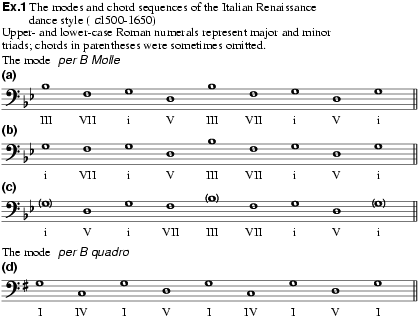
A melody, usually in the bass and hence often called a ground bass (basso ostinato in Italian), recurring many times in succession, accompanied by continuous variation in the upper parts. The term ‘ground’ may refer to the bass melody itself, to an entire musical scheme including the harmonies and upper voices, to the process of repetition in general, or to a composition in which it occurs. The word was first used in England late in the 16th century and appeared frequently there throughout the Baroque period, sometimes associated with improvisation; modern scholars have also applied the term to the same technique in other countries and in other periods of history. In addition, it has occassionally been applied to the Ostinato recurrence of an esentially harmonic progression, which may or may not be accompanied by an exactly recurring bass line.
Antecedents of ground technique may be found in some of the earliest forms of polyphony, but its immediate origins lie in the repeated chordal schemes associated with Renaissance dances. These schemes consist of fixed successions of root-position triads and were used from the end of the 15th century to about 1650 for the construction of musical frameworks. The chords of each scheme (ex.1) could be disposed in various rhythmic structures for different forms: the romanesca, favorita and the Spanish song Guárdame las vacas (ex.1a); the passamezzo antico, ballo del fiore and paganina (ex.1b); the folia, pavaniglia, spagnoletta and some Spanish pavanas (ex.1c; the same scheme, with the structure shown in ex.2, was also used in pieces called La cara cosa, La gamba and J’aimerais mieux); and the Italian passamezzo moderno, English quadran pavan and Spanish villano and zarabanda (ex.1d) (see Folia and Passamezzo).

In his Tratado de glosas (Rome, 1553) Diego Ortiz presented a series of recercadas in which the chordal schemes, called here ‘Italian tenors’, are repeated many times on a keyboard instrument as the accompaniment for continuous variations on a viol (the keyboard part for recercadas quarta and ottava, for example, is almost identical with ex.2). When used for songs or dances the schemes were often repeated a number of times; hence many instrumental pieces use the chord progressions as harmonic grounds. Variation of a chordal framework such as that in ex.2 could involve melodic activation of all the voices, including the bass, or the insertion of new chords preceding or following a single framework chord, relating to it as V or IV–V to I. The repetition of a simple chord succession such as ex.2 naturally produces a repeated bass line and hence, in a sense, a melodic ground; however, the essential harmonic nature of the schemes in ex.1 is confirmed by the fact that variation is usually applied in such a way that no melodic ground occurs. (For an illustration of both melodic and chordal variation, see HAM, no.154b, which presents excerpts from six continuous keyboard variations on ex.1b by Giovanni Picchi, and HAM, no.124, a set of vihuela diferencias by Valderrábano on ex.1a.)
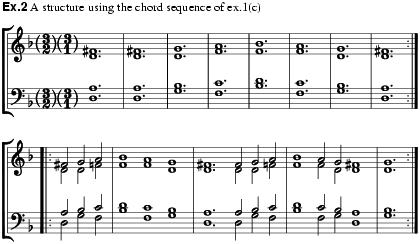
Often the recurrence of the chordal scheme was preceded by two brief riprese or ritornellos (see Ripresa). At the end of a song or dance, or especially at the end of a dance pair, longer chains of riprese appeared, which involved the random recurrence of certain derived harmonic formulae. Within a single set of riprese a composer was free to alternate patterns as he wished, or to repeat one for a number of phrases. Bernardino Balletti wrote an independent set of 57 riprese(1554) which opens with 12 repetitions of I–IV–V but then turns to different harmonic progressions. The riprese and ritornellos thus represent a special type of ostinato that usually involves changing harmonic patterns, but may on occasion present a strict harmonic ground.
In Spain a harmonic ground used in continuous diferencias by a number of composers was Conde claros, based on the brief progression I–IV–V. The zarabanda, villano and canario, popular dances in Spain around 1600, repeated the ground I–I–IV–V–I. In England an even simpler harmonic ground occurs in My Lady Carey’s Dompe (HAM, no.103), in which two bars of I alternate with two bars of V.
During the first half of the 17th century musical frameworks that had developed within the Renaissance dance style, such as the monica, pavaniglia, spagnoletta, bergamasca, fedele, Ruggiero, romanesca and the earlier type of folia, were used for continuous or non-continuous sets of variations. Some of these forms, though originating probably as harmonic grounds, developed during the Baroque period with greater emphasis on a melodic bass line. Composers of vocal music turned to ground basses as one means of achieving organization without interfering with the freedom of the vocal part to express the meaning of the text. Numerous examples occur in the works of Monteverdi, some repeated many times (ex.3a), others only a few times within a larger work (ex.3b). A minor-mode version of ex.3b appears often in the Lamento, sometimes melodically ornamented (ex.3c), sometimes in a chromatic form (ex.3d).
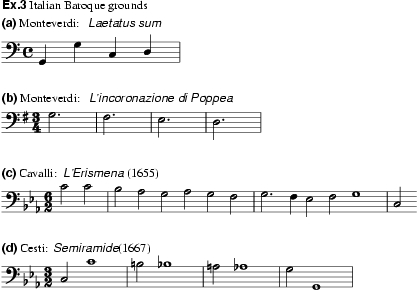
At the same time the Passacaglia and Chaconne developed out of the Renaissance ripresa, but with the formulae now sometimes conceived as bass melodies rather than harmonic progressions. The passacaglia and chaconne were both in triple time. During most of the 17th century the passacaglia was normally in the minor, typically a four-note pattern descending by step, and the chaconne was normally in the major, a well-known example being the formula used in Monteverdi’s Zefiro torna. In the late 17th century the distinctions between the passacaglia and the chaconne began to blur, the passacaglia’s descending bass pattern appearing in the major, for instance. The passacaglia-chaconne ostinato in its broadest sense involved the selection for each phrase in a piece of one of the bass formulae that had evolved for each form. Ordinarily this process produced a random alternation between different but related basses. Sometimes, however, a strict ground bass resulted, especially in continuo vocal music from 1625 to 1650, and occasionally in continuo ensemble music during the second half of the century. It is important to note that a piece using the grounds of ex.3 was not considered by its composer to be necessarily either a passacaglia or a chaconne; hence it is probably wise to apply these terms only when they actually appear in the title of a work. Many later Baroque grounds are essentially extensions of the passacaglia bass, to which a cadence has been added; some of Handel’s provide good examples.
Grounds appeared also in German music, both vocal (ex.4a) and instrumental (ex.4b). Early examples include William Brade’s ‘coral’ divisions for violin, settings of the bergamasca and passamezzo in the recently rediscovered Breslau violin manuscripts and vocal grounds by, among others, Schütz (e.g. his arrangement of Monteverdi’s Chiome d’oro). The German tradition culminated in the keyboard passacaglias and chaconnes of Buxtehude, Handel and Bach.

English literary and musical sources indicate that the term ‘ground’ was in common use in the late 16th and early 17th centuries to mean the cantus firmus on which a discant is based. In Shakespeare’s Richard III, for example, the Duke of Buckingham states that ‘on that ground I’ll make a Holy Descant’ (Act 3 scene vii, line 49). John Farmer (i) used the term in his Divers and Sundry Waies (1591) to refer to a plainchant cantus firmus to which new parts are added above and below; Morley used the word in a similar manner (A Plaine and Easie Introduction to Practicall Musicke, 1597), but said that when the new part was to be improvised below the plainchant this lowest voice became the ground. No repetition is involved with the grounds of Farmer or Morley, so the term meant simply the foundation (hence ‘ground’) on which a piece was based.
Among the earliest English grounds are My Lady Carey’s Dompe and Hugh Aston’s Hornepype (both in GB-Lbl Roy.App.58, c1540), some early lute dumps (see Dump) and pieces in the Dublin Virginal Book (IRL-Dm D.3.30, c1570). Most 16th-century English grounds are based on one of the standard Italian chord sequences, such as the passamezzo, romanesca, Ruggiero or bergamasca. Byrd used the term as the title for entire pieces. His bass melodies vary in length (cf exx.5a and 5b); the title of ex.5b shows that melodies for such pieces could be drawn from the works of other composers – often works, no doubt, in which the melody was not used as a ground. Sometimes the ground bass is first heard alone, sometimes not. The piece entitled The Bells (MB, xxvii, 1969, 2/1976, p.132) has a two-note basso ostinato, but is not designated a ground by Byrd. Other composers moved the ground occasionally to other voices (ex.5c occurs mostly in upper voices), and even changed key (see the example by Farnaby, MB, xxiv, 1965, p.2). Grounds may be melodically vague (ex.5b) or more structured and easily remembered (exx.5d and 5e).

In 1659 Christopher Simpson (The Division-Viol or the Art of Playing Ex tempore upon a Ground) gave detailed instructions for breaking a ground into smaller note values or for adding a new melody (see Division). Thomas Mace (Musick’s Monument, 1676, p.129) wrote that:
The Ground, is a set Number of Slow Notes, very Grave, and Stately; which (after It is express’d Once, or Twice, very Plainly) then He that hath Good Brains, and a Good Hand, undertakes to Play several Divisions upon It, Time after Time, till he has shew’d his Bravery, both of Invention, and Hand.
Simpson stated the ground bass only once in each of the pieces at the end of his book; some of his grounds take on a rhythmic animation (ex.5f), others move mainly in long notes (ex.5g, which is a melodic version of the chordal scheme in ex.1c). Dances such as the pavan or allemande were often used as the basis of pieces on a ground in the early division viol repertory (this is why many such grounds are in two sections, the traditional structure of dance forms).
In later English sources the word ‘ground’ seems to refer to an entire musical framework, including upper voices as well as bass and harmonies. Farinelli’s Ground, for example, refers to the music popular in France as the folies d’Espagne; its bass line (derived also from ex.1c) is called the ‘ground bass’, meaning ‘the bass of the ground’. The bass in ex.5h was included in Humphrey Salter’s The Genteel Companion (1683) as ‘Mr. Reddins Ground, the basse to it’. In the original version of ‘Mr. Reddins Ground’ (a piece for scordatura violin and continuo, probably by Valentine Reading) the bass is varied, and Salter’s and Playford’s reduction of it to a simple statement gives a misleading impression. Playford’s The Division-Violin of 1685 contains two pieces on the ground John Come Kiss, treated in much the same way as in Byrd’s earlier keyboard variations on the same tune. Playford usually entitled his pieces ‘A Division upon a Ground’, giving the violin part and then a single statement of ‘the ground basse’. In one case the word ‘ground’ appears under the opening statement of the violin part, whereas the bass melody is labelled ‘the basse to the ground’. Occasionally the ground bass itself is varied, as in one piece in The Division-Violin and one in the English manuscript of keyboard music F-Pc Rés.1186 bis. The latter source also has a rare example of a ground in which the entire opening statement reappears as a refrain a number of times throughout the piece and at the end.
Up to the 1670s English instrumental grounds were mainly for solo instruments (especially for lute, viol or keyboard). Thereafter composers, notably Robert Smith, John Blow and Purcell, began writing consort grounds, partly as the result of the influence of Lully’s orchestral chaconnes and passacaglias. The English ground reached a highpoint in the vocal and instrumental music of Purcell (numerous examples, including the famous lament from Dido and Aeneas) and his contemporaries such as Blow, Croft and Eccles. (For the development of the vocal ground in England see P. Holman: Henry Purcell, New York and Oxford, 1994, pp.36–8.)
Grounds are relatively rare during the Classical and Romantic periods. However, the technique of theme and variations (see Variations) is based largely on a recurring harmonic scheme; hence, when such variations are continuous, as in the last movement of Beethoven’s ‘Eroica’ Symphony, they technically fall into the category of a harmonic ground; the ‘Eroica’ movement, in addition, opens with a series of variations on the melodic bass line of the theme. Beethoven’s Thirty-Two Variations in C minor and the fourth movement of Brahms’s Symphony no.4 employ both a harmonic and a melodic ground, but each set is based primarily on the conjunct melodic movement from the tonic up to the 5th or 6th degree in the upper voice of the opening statement. Brahms used this melody also in the lowest voice for a series of variations, thus creating temporarily a melodic ground bass. Chopin’s Berceuse has a harmonic ground, and the melodic type appears in Liszt’s Variations on a Theme of Bach (the ground used in the ‘Crucifixus’ of the Mass in B minor and in the opening chorus of the cantata Weinen, Klagen, Sorgen, Zagen), the concluding movement of Brahms’s Variations on the St Anthony Chorale and the beginning of Franck’s B minor chorale for organ.
Contemporary music has shown a tremendous interest in the melodic ground, rivalling perhaps even the Baroque period. One type is a sort of motivic ground, in which the repeated unit is so short that it has the effect of a melodically ornamented pedal point; as such it serves to emphasize a tone centre, especially important when traditional tonality is absent. (Ex.6 shows some of these short grounds: the bass in the first two bars of ex.6c is heard six times, followed later by eight statements of the pattern in the last two; in ex.6d the top voice has a one-bar ostinato figure in 3/2 against a one-and-one-third bar ground bass actually in 4/2.) These short grounds ordinarily occur within a larger composition, but many 20th-century composers have also written entire pieces, many entitled ‘passacaglia’, in which the dominating constructive element is a longer and melodically more substantial ground (ex.7).
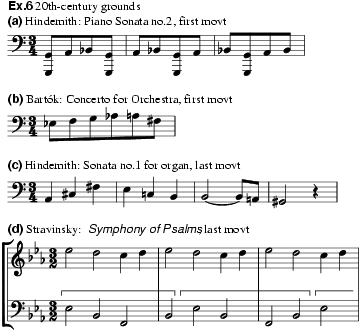
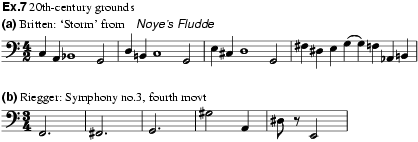
For bibliography see Ostinato.
RICHARD HUDSON/R